 Although more than a century and a quarter has passed since publication of Arthur Conan Doyle’s first story, Sherlock Holmes continues to inspire novels, movies, TV, and the stage. I will review some of the actors who played Holmes in this concluding essay in my Holmes duology; and assess how true each was to Conan Doyle’s artistic vision.
Although more than a century and a quarter has passed since publication of Arthur Conan Doyle’s first story, Sherlock Holmes continues to inspire novels, movies, TV, and the stage. I will review some of the actors who played Holmes in this concluding essay in my Holmes duology; and assess how true each was to Conan Doyle’s artistic vision.
Where possible, I’ll contrast each actor’s portrayal with the Holmes described by Dr. Watson, which I have paraphrased as, “His very person was such as to strike the attention of the most casual observer. He was rather over six feet, and so lean that he seemed considerably taller. His eyes were sharp and piercing, and his thin, hawk-like nose and prominent chin gave his whole expression an air of alertness, decision, and determination.”
Note that I occasionally will refer to the “canon” in this essay, which consists of the 56 short stories and four novels written by Sir Arthur Conan Doyle and published in the Strand Magazine.
This is no easy task. In 2012, one of the world’s most reliable sources, i.e., The Guiness Book of World Records, awarded the title for “most portrayed literary human character in film & television” to Sherlock Holmes, who had already been presented on screen, at that time, more than 250 times. He has been played. in some manner, by nearly 100 actors, including Michael Caine, Benedict Cumberbatch, Christopher Lee, Robert Downey Jr., Ian McKellen, Jonny Miller, Peter O’Toole, Christopher Plummer, and Basil Rathbone.
However, I will focus only on the MSM, that is, the Main-Sherlock-Media, and exclude the “Sherlocks” in parodies like Without a Clue, The Adventures of Sherlock Holmes’ Smarter Brother, and The Great Mouse Detective.
Sherlockian Literature After Sir Arthur Conan Doyle
Award-winning American playwright, Ken Ludwig, set The Game’s Afoot at a cast party in 1936 Gillette Castle. Published in 2012, the play was presented at the Ivoryton Playhouse in 2017. Jim Bennet, of Mystic, has written three historical mysteries regarding William Gillette under the pen name James Walker; in these, Gillette uses his stage persona as Sherlock Holmes to investigate murders and other crimes.
In addition, a growing group of authors is writing short stories and novels “in the style of Arthur Conan Doyle”. Many of these “pastiches” are quite accurate in their portrayals and have begun to form a subcategory of popular literature.
Sherlock in the Cinema and on TV
Rather than attempt an exhaustive review of every actor who has portrayed Sherlock in any television or movie production, I will begin this review in the late 1930s with Basil Rathbone’s interpretation, and continue chronologically to the present.
I feel that any review of Sherlock must also consider the associated Dr. Watson. However, I will not review the concomitant LeStrade or Moriarty characters in this essay.
I don’t pretend to have the expertise of Old Lyme resident David Handler’s character Mitch Berger of Dorset in judging these actors, but I can certainly distinguish good acting from bad; and sloppy dialog from a well-constructed plot. Moreover, in the spirit of some current American politicians, there’s absolutely no science in these assessments, although I’ll start with the null hypothesis that Basil Rathbone is Sherlock, and attempt to disprove that premise.
Basil Rathbone

In 1939, Basil Rathbone played Holmes in The Hound of the Baskervilles with Nigel Bruce as Watson. They continued through 1946 and completed 14 Sherlock Holmes movies. Almost concurrent with movie production, they also starred in a serialized radio drama, The New Adventures of Sherlock Holmes, that aired in the United States from late 1939 through mid-1947.
With the exception of Hound, these films were only loosely based on Arthur Conan Doyle’s canon, but were updated to reflect the issues of the day. I’m not claiming that all 14 were great cinema; but they certainly were respectable wartime productions.
So, by mid-century, the Rathbone/Bruce team was recognized and accepted in both America and Great Britain as Holmes and Watson. I’ll reference only two movies to support my claim.
In Sherlock Holmes and the Secret Weapon, Holmes, disguised as an elderly book seller, smuggles a Swiss scientist and his advanced bomb sight into England just as the Gestapo prepared to arrest him and seize control of his laboratory. Many of the Holmes’ wartime movies ended with a soliloquy by Basil Rathbone. This one always brings a few tears to my eyes.
At the end of Secret Weapon, Holmes and Watson, with a contingent of the British war cabinet, are observing a squadron of Lancaster bombers equipped with the bombsight as they leave for Nazi Germany.
Watson: “Things are looking up, Holmes. This little Island’s still on the map”.
Holmes: “Yes. “This fortress – built by nature for herself; This blessed plot, this Earth, this Rome, this England”.
This latter line is, of course, from Act II of Richard II by William Shakespeare.
In Sherlock Holmes in Washington, Holmes breaks up a Nazi spy ring operating from a high-end D.C. antiques shop, and recovers the secret microfilmed documents that they had stolen from a murdered British intelligence agent.
As Holmes and Watson prepare to leave the District, driving towards Capitol Hill, the conversation goes like this:
Holmes: “Look up there ahead – the Capitol, the very heart of this democracy”.
Watson: “Democracy; the only hope for the future?
Holmes: “It’s not given to us to peer into the mysteries of the future, but in the days to come the British and American people will, for their own safety and for the good of all, walk together in majesty, in justice, and in peace”.
In citing Churchill’s then recent address to Congress, Sherlock reminds us of how great that legislative body once was.
While Basil Rathbone was Sherlock, both physically and intellectually, Nigel Bruce regularly presented Watson as a befuddled English gentleman and a somewhat slower associate of Holmes. His interpretation of Watson is inconsistent with the more intelligent Watson of Arthur Conan Doyle’s canon.
Ronald Howard
In 1954, British actor Ronald Howard began a two-season run of 39 episodes on the American television series Sherlock Holmes. He played a relatively light-hearted and campy Sherlock along-side H. Marion Crawford’s Dr. Watson; who played a sharp, and sometimes aggressive Watson, unlike Nigel Bruce above. Of the 39 episodes, only The Red-Headed League was based on Arthur Conan Doyle’s original body of work. The series included such titles as: The Case of the Texas Cowgirl, and The Case of The Shoeless Engineer. However, there were occasional allusions to the Doyle canon.
Douglas Wilmer
In 1965, the BBC began its presentation of Sherlock Holmes with British classical actor Douglas Wilmer as the lead, and Nigel Stock as Watson. This sometimes “noirish” series continued until 1968, with 13 episodes wholly- based on the original stories. Wilmer plays a shrewd, but arrogant Holmes; and sports all the expected trappings: deerstalker cap, pipe, prominent nose, and obsessive nature. Nigel Stock is another affable, but intellectually inferior Watson.
Jeremy Brett
In the Granada Television series that aired in the UK from 1984 to 1994, Jeremy Brett played a more emotional and physically graceful Sherlock than the predecessor Sherlocks described above. His manner was more “swaggering” with occasional outbursts of passion used to re-focus Watson or LeStrade
His sometimes overly-precise and dramatic presentation quality demonstrate his background in musical theater. He played Freddy Eynsford-Hill” in My Fair Lady. Here’s a clue for you: “I have often walked down this street before; but the pavement always stayed beneath my feet before. All at once am I several stories high, knowing I’m on the street where you live …”
There were two Watsons over this decade-long series, namely David Burke and Edward Hardwicke. Both played the character as a highly intelligent and intuitive associate of Holmes, and true to Doyle’s canon. Many consider Jeremy Brett’s characterization of Holmes as the defining Sherlock performance. To get a feel for his style, watch this video clip to see Holmes leap the couch at 221B in The Red Headed League.
Benedict Cumberbatch

Sherlock is a contemporized version of Arthur Conan Doyle’s consulting detective now operating in 21st century London. Cumberbatch is Holmes, and Martin Freeman is Watson. Thirteen 90-minute episodes were produced in this BBC/PBS series between 2010 and 2017. The Cumberbatch Holmes is more arrogant and self-centered than the predecessors described above, and less-willing to contend with Inspector LeStrade’s plodding manner.
The deerstalker cap is absent, although other traditional detective attire (long coat and scarf) frequently appear. I believe that, although updated with contemporary technology, and despite the unruly hair, Cumberbatch’s portrayal of the character is first rate. His Holmes still has exceptional intellect, is excitable, and delights in “solving puzzles no one else could solve.”
Dr. Watson is a younger veteran of the Royal Army Medical Corps in the Afghan War than those reviewed above and is certainly played as a more independent “self-starter”. He blogs about their adventures rather than writing by hand for publication in the print media.
However, Watson’s blog provides the pair some unwanted celebrity and the press begins reporting on the cases and Sherlock’s sometimes eccentric personal life. Their cases, like those in the canon, come from both ordinary people and the British government.
Jonny Miller
Elementary first aired in 2012, and ran for seven seasons and over 150 episodes. There is little connection to Arthur Conan Doyle’s body of work beyond some character names and occasional allusions to the original stories.
Elementary is really a “police procedural” with Jonny Miller as Sherlock Holmes, and Lucy Liu as Dr. Joan Watson. Sherlock is a recovering drug addict and former consultant to Scotland Yard, who has re-located to a Brooklyn brownstone in present-day New York City for addiction treatment.
Watson is a former surgeon who has left practice, and is hired by Sherlock’s father to assist in his rehabilitation as his sober companion. Watson’s relationship with Holmes evolves from sober companion, to investigative apprentice, and into a professional crime-solving partnership with Sherlock and the NYPD.
This Holmes is, of course, indifferent to proper procedure as he works with the NYPD. one critic describes the series as, “pretty good television; the stories are unpredictable, and often draw on contemporary issues like hacking, cyber-espionage, and corruption in international finance. I don’t recall whether the latter was Deutsche Bank. There is a definite “psychological component” underlying the series and the plots often include the characters’ struggles to deal with their many demons.
Robert Downey Jr.
Downey is not, by any stretch of the imagination, Sherlock Holmes. Others disagree, as a third movie is apparently in progress, beyond Sherlock Holmes (2009), and A Game of Shadows (2011). His interpretation is more vulgar and more cynical than those reviewed above. There is significant violence in the plots, perhaps because the movies are targeting a less-sophisticated and/or a teenaged audience. The first two movies are totally lacking in subtlety and I think of them as the violent video games that you want your children to avoid.
Some Final Thoughts
I always pass my penultimate draft by my wife, Christina. Her comments were that, “the essay is well-punctuated, but maybe a little obsessive.” I agree that I punctuate well.
I have watched each of theafore-mentioned movies or TV shows at least once; either on DVD, or for the more recent ones, on television or in the theater. To explain, nine years ago next Halloween, I had just finished a two-year period during which I had almost unlimited time for reading and the media. I wasn’t incarcerated or unemployed; and, although I am a Navy veteran, I was not a member of a ballistic missile submarine team rotated ashore.
I have also concluded that Senator Blumenthal does bear some resemblance to the Holmes described by Dr. Watson in the first paragraph of this essay; and certainly, his activities as Connecticut Attorney General also required some of the fundamental skills of a “consulting detective”. Our junior senator could, conceivably, be Watson. This is not a political column, so I won’t name any of the more obvious candidates for Moriarty.
The next essay changes focus from human icons to Connecticut’s iconic Long Island Sound and the rising water levels that I have observed from my porch over the past several years.

Tom Gotowka
About the author: Tom Gotowka’s entire adult career has been in healthcare. He’ will sit on the Navy side at the Army/Navy football game. He always sit on the crimson side at any Harvard/Yale contest. He enjoys reading historic speeches and considers himself a scholar of the period from FDR through JFK.
A child of AM Radio, he probably knows the lyrics of every rock and roll or folk song published since 1960. He hopes these experiences give readers a sense of what he believes “qualify” him to write this column.
Thank you for another fascinating article! I’m curious about the Christoper Plummer portrayal; he didn’t look much like Watson’s description—or Gillette, Basil R or Robert D Jr., for that matter.
Interested to hear about local climate change in your next piece.